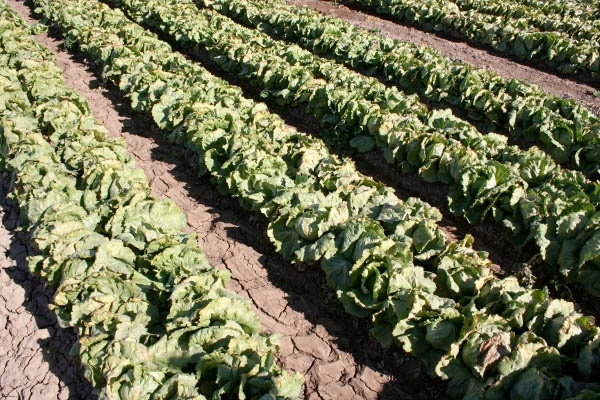
The biology and epidemiology of plant virus pathogens is a complicated one in that usually such systems involve the susceptible host plant, a virulent or infectious virus agent, and a vector organism that carries and transmits the virus. A “vector” can be defined as an organism that can acquire and subsequently transmit a pathogen (mostly viruses but also fungi and bacteria) to plants.
December 21, 2010

This article is a brief review of the vectors that transmit viruses to crops grown in our central coast region. As is evident from several on-going disease issues (Apium virus Y in celery, Impatiens necrotic spot virus of lettuce, Tomato spotted wilt virus of lettuce/pepper/tomato), viruses can be important and damaging pathogens.
The biology and epidemiology of plant virus pathogens is a complicated one in that usually such systems involve the susceptible host plant, a virulent or infectious virus agent, and a vector organism that carries and transmits the virus. A “vector” can be defined as an organism that can acquire and subsequently transmit a pathogen (mostly viruses but also fungi and bacteria) to plants.
In general, viruses do not exist and survive in nature without another organism. The plant host is the primary refuge of viruses. Once inside a host plant, viruses usually cannot spread to other plants without the help of external factors (exceptions are those viruses that are capable of being transmitted by pollen, carried by seed, or transmitted when roots of an infected plant touch and graft with roots from a healthy plant). One such external factor is commercial plant propagation practices. When plants are propagated commercially via cuttings or crown divisions (such as artichokes), viruses present in the mother stock will also be present in the propagated material.
The other major external factor that spreads viruses is a vector. Vectors feed on the infected plant, become contaminated or infested with the virus, then move to healthy plants and infect them by feeding. Arthropods (insects and mites) are the most common plant virus vectors, though nematodes and primitive soil microorganisms can also transmit these pathogens.
Hemiptera insects: The Hemiptera order of insects contains the most important virus vectors and includes aphids, leafhoppers, whiteflies, and mealybugs. Taxonomically, these insects were formerly placed in the order Homoptera but now are reassigned to suborders within Hemiptera.
Of these vectors, aphids transmit the greatest number of viruses affecting plants; for vegetables grown in coastal California, leafhoppers are the only other Hemipteran that vectors viruses, spreading Beet curly top virus. Note that leafhoppers also vector bacterial pathogens such as the aster yellows and Pierce’s disease bacteria.
Thrips:In addition to being important plant pests in their own right, thrips insects also are vectors of viruses. Worldwide there may be a dozen or so viruses (called Tosporviruses) that are vectored by only a few species of thrips. In our region, Impatiens necrotic spot virus and Tomato spotted wilt virus are damaging pathogens that affect many of vegetable and ornamental crops.
While not yet documented in coastal California, the Tospovirus Iris yellow spot virus is a concern for onion and related crops.
Nematodes:Soilborne nematodes in the Longidoridae family (genera are Trichodorus, Paratrichodorus, Longidorus, Paralongidorus, and Xiphinema) transmit viruses. It is notable that such viruses have evolved this complex relationship solely with the nematode carriers and are not vectored by aphids or other organisms. In California, for example, Trichodorus and Paratrichodorus nematodes vector Tobacco rattle virus to spinach. For grapes, Xiphinema americanum vectors Tomato ringspot virus and X. index vectors Grapevine fanleaf virus.
Soil microbes:Soil microorganisms such as Olpidium and Polymyxa are free-living soil inhabitants that can also infect and colonize the roots of plants. Some isolates of these organisms carry and vector plant viruses. Olpidium brassicae is a primitive fungus (called a chytrid) that vectors Mirafiori lettuce virus, causal pathogen of lettuce big vein disease. Polymyxa betae is a primitive organism (called a plasmodiophorid protist) that is closely related to the pathogen that causes clubroot disease of crucifers; P. betae vectors beet necrotic yellow vein virus to spinach and sugar beets.
Management of virus diseases relies on typical integrated pest management strategies that include the following: plant resistant cultivars if available; plant seed or other propagative materials that are virus free; remove and control reservoir hosts such as overwintering weeds and crop volunteer plants; plow down and destroy old, harvested crops; avoid planting susceptible crops in areas that have a history of persistent virus problems; practice crop rotation so that the same crop is not continually present; manage the virus vector.
Controlling insect vectors by using insecticides and other measures is an important consideration in managing virus diseases. However, researchers have clearly shown that while vector control is an appropriate step, managing the insects will not necessarily prevent infection. Insects need only a few minutes to feed on plants and transmit the virus; therefore, spray applications and other steps do not operate rapidly enough to prevent this transmission. Direct management of soilborne nematode and microbe vectors is likewise of limited effectiveness. Soil-applied fumigants can reduce but not completely eliminate soil populations of these vector organisms.
You May Also Like



